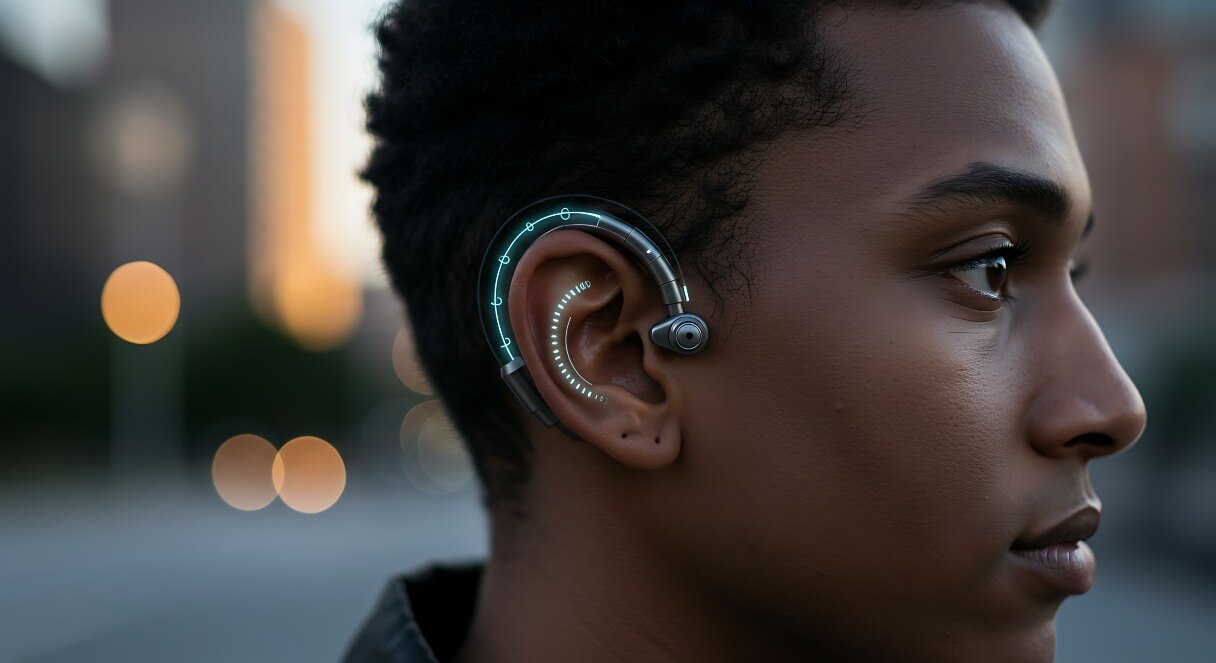5 Hearing Device Trends Shaping the Future of Audiology Care
Hearing devices continue to evolve along with technology developments and consumer interests. Audiologists can better serve their patients by staying on top of the trends.
By Nancy Mann Jackson
Digital Writer
Posted Oct 17, 2025 - 5 min read

Key Takeaways
- Advancements in hearing devices, from AI integration to telehealth capabilities, are helping transform audiology care with more personalized, accessible and tech-forward solutions.
- As consumer tech brands and over-the-counter options enter the space, audiologists may have new opportunities to educate patients and provide expert guidance for optimized hearing outcomes.
- By embracing trends like 3D printing, app connectivity and preventive care tools, hearing care professionals can better meet evolving patient expectations.
As technology and consumer interests evolve, hearing devices continue to advance to meet the needs of all age groups. Hearing wellness is an important part of overall health, especially for aging populations who may be experiencing unnoticed hearing loss, but also for younger individuals facing increasing noise exposure. By staying informed on the latest developments in hearing devices, audiologists can better serve the diverse needs of their patients.
Recent trends in hearing devices are driven not only by cutting-edge technology but also by changing regulations and increased awareness about hearing health. For patients hesitant to adopt hearing devices or who hold misconceptions about them, these trends offer new opportunities to engage and motivate them toward proactive hearing care.
To navigate this changing landscape and provide the best care possible, hearing care professionals can familiarize themselves with these five trends shaping the future of hearing devices.
1. Consumer Tech Giants Enter Preventive Hearing Care
Some of the most trusted consumer technology brands are taking steps to get involved in preventive hearing care. For example, Apple recently released AirPods Pro 2, which comes with the ability to access a hearing test and a hearing aid feature.1
Many modern hearing devices already offer connectivity with smartphones through Bluetooth®. Wearers can connect their hearing aids to an app on their smartphones and use the app to control volume and sound settings, track battery life and find lost hearing devices.
As popular consumer technology companies acknowledge the prevalence of hearing loss and offer accessible solutions, patients may become more open to using hearing devices. For those hesitant to embrace the devices they need, sharing news about familiar consumer tech products can serve as a helpful introduction to the benefits of improved hearing.
2. AI-Powered Hearing Devices Enhance Personalized Care
Artificial intelligence (AI) is transforming numerous industries and technologies, and hearing devices are no exception. Like other wearables, hearing aids can be programmed with AI technology to track wearers’ habits and environments to provide hearing care professionals with advanced data to inform their care.
In the near future, AI-enabled hearing devices could potentially send real-time biometrics or other information to audiologists, as well as provide users with feedback, such as alerting them to high-risk noise environments.2
In addition, AI-enabled hearing devices continuously analyze the sounds in a patient’s environment, automatically adapting to deliver a more natural and clear listening experience. Over time, as patients use these devices, the AI learns to predict what settings will work best for the patient in different situations.3
3. Over-the-Counter Hearing Aids Expand Accessibility
The market for over-the-counter (OTC) hearing devices has exploded since they were approved by the U.S. Food and Drug Administration in 2022. Globally, the OTC hearing aid market size is projected to reach $996.36 million in 2025 and is expected to grow significantly by 2035, with a compounded annual growth rate of 6.1%.4
While OTC hearing aids may not require a prescription and professional fitting from a hearing care professional, audiologists continue to play an important role in supporting patients who choose these devices. Offering services such as hearing exams and personalized guidance on selection and fitting, as well as customization, can help patients get the most benefit from OTC options.
Additionally, by working directly with pharmacists, hearing care professionals can enhance their ability to assist customers in need of hearing devices.5
4. 3D Printing Transforms Custom Ear Mold Production
Customized ear molds, designed to fit each patient’s ear canal, are increasingly common for hearing protection and effectively channeling sound from hearing aids to the eardrum. Traditionally, patients waited weeks for these custom-made ear molds, but advances in 3D printing have significantly accelerated the process.6
Audiologists who want to provide customized ear molds with a fast turnaround may consider investing in a 3D printer and accompanying software. Instead of taking physical ear impressions, a digital scan of the ear can be used to produce highly accurate and personalized ear molds.7
5. Telehealth Expands Audiology Services Beyond the Clinic
While you might currently prefer using telehealth primarily for patient counseling and education, you may want to consider using telehealth for the following services:
- Otoscopy
- Pure-tone and imminence audiometry
- Otoacoustic emissions assessments
- Auditory brainstem assessments
- Fitting, verifying and maintaining hearing devices and cochlear implants
Audiologists Can Capitalize on the Trends
As hearing patients experience new technologies and customization in other products, they are likely to expect the same trends and service levels from their hearing care professionals. For example, new technology makes it possible to provide hearing devices that are smaller, discreet, stylish and customizable, which may make them more appealing to patients of all ages.
Audiologists who stay informed about the latest trends in hearing devices and keep up with the newest developments in their practices may be better prepared to stay competitive and provide their patients with the services and solutions they expect.
A Patient Financing Solution for Your Hearing Care Practice
If you want to help your patients manage the cost of your practice’s exams, procedures and products, consider offering the CareCredit credit card as a financing solution. CareCredit allows cardholders to pay for things like hearing care services and devices over time while helping to enhance the payments process for your practice.
When you accept CareCredit, patients can see if they prequalify with no impact to their credit score, and those who apply, if approved, can take advantage of special financing on qualifying purchases.* Additionally, you will be paid directly within two business days.
Learn more about the CareCredit credit card as a patient financing solution for your hearing care practice or start the provider enrollment process by filling out this form.
Author Bio
Nancy Mann Jackson is a journalist and content writer who writes regularly about finance and healthcare. Her work has been published by AARP, CNBC, Entrepreneur and Fortune.
Healthcare payment and financing solution
The CareCredit health and wellness credit card helps improve the payment experience for patients and clients, and your financial performance.
Get StartedReady to help more patients and clients get the care they want and need?
Get StartedReady to help more patients and clients get the care they want and need?
Get Started*Subject to credit approval.
The information, opinions and recommendations expressed in the article are for informational purposes only. Information has been obtained from sources generally believed to be reliable. However, because of the possibility of human or mechanical error by our sources, or any other, Synchrony and any of its affiliates, including CareCredit, (collectively, “Synchrony”) does not provide any warranty as to the accuracy, adequacy or completeness of any information for its intended purpose or any results obtained from the use of such information. The data presented in the article was current as of the time of writing. Please consult with your individual advisors with respect to any information presented.
All product, service and company names are the trademarks of their original owners. The use of any trade name or trademark is for identification and reference only and does not imply any endorsement, sponsorship or affiliation by or with the trademark holder of their brand.
© 2025 Synchrony Bank.
Sources:
1 “4 things to know about those new Apple hearing aids,” January 7, 2025. Audiology Hearing Health. Retrieved from: https://www.audiologyandhearing.com/blog/about-those-apple-hearing-aids/
2 Freeman, Barry A. et al. “The future of audiology: Surviving and thriving,” Audiology Today. March/April 2025. Retrieved from: https://www.audiology.org/news-and-publications/audiology-today/articles/the-future-of-audiology-surviving-and-thriving/
3 “The role of AI in improving hearing aid performance,” March 21, 2025. Harbor Audiology and Hearing Services. Retrieved from: https://harboraudiology.com/the-role-of-ai-in-improving-hearing-aid-performance/
4 Pawar, Radhika. “Over-the-counter (OTC) hearing aids market size and forecast, by product (receiver in canal, completely in the canal, earbuds); type; distribution channel — growth trends, key players, regional analysis 2026-2035,” Research Nester. April 18, 2025. Retrieved from: https://www.researchnester.com/reports/over-the-counter-hearing-aids-market/6704
5 “Over-the-counter hearing aids: Tools for audiologists,” American Speech-Language-Hearing Association. Accessed September 30, 2025. Retrieved from: https://www.asha.org/aud/otc-hearing-aid-toolkit/tools-for-audiologists/
6 Pugliese, Christina. “New lab enables efficient 3D printing for hearing-aid earmolds,” The University of Texas at Dallas. August 8, 2024. Retrieved from: https://news.utdallas.edu/health-medicine/new-callier-lab-2024/
7 “The impact of 3D printing on hearing aid manufacturing,” Kricket Audiology. April 24, 2025. Retrieved from: https://kricketaudiology.com/the-impact-of-3d-printing-on-hearing-aid-manufacturing/




